8 essential e-commerce email marketing automations for more sales and less work
 Natalia, customer support manager
Natalia, customer support manager
Busy e-commerce store owners typically want 2 things: more sales and more time. E-commerce email marketing automations bring you both. Set them up once, and they’ll generate sales continually while freeing up your schedule for other tasks.
There are tons of automations you can create, but you don’t need to do them all at once. The key is to discover which ones move the needle and start with these. You can then set up more advanced automations as you learn what works with your audience.
This article will help by showing you the most impactful automations for e-commerce stores and go through essential tips you can use when setting them up.
A quick intro to E-commerce email marketing automations
E-commerce email automations are automated emails that go out at specific points in the customer journey. They allow you to contact customers when they need to hear from you, boosting sales and improving the customer experience.
The beauty of e-commerce email automations is that you truly can set and forget. Once you create your automation, it will take the predefined step whenever someone triggers it, whether that’s for your 100th customer or your one millionth.
Automations rely on triggers
Email automations work by performing an action based on a predefined trigger. This action is typically sending an email, but it could also be adding a subscriber to a group or updating a field in their profile.
MailerLite has 10 automation triggers you can use to start an automation, including 4 that are specific to e-commerce stores. You can access these as soon as you connect your store to MailerLite with an e-commerce integration.
It's easy to connect MailerLite to your e-commerce store with a prebuilt automation. See the guides below for instructions relevant to your platform.
You can also use multiple triggers for a single workflow. This saves time as it means you don’t have to create a new workflow for every trigger. For example, you could send the same welcome email to people who complete different website forms.
Your options are almost endless
It’s possible to create everything from a single email automation, to an entire email series with multiple messages and routes that change based on customer behavior.
This flexibility is possible because, as well as the 10 triggers that start the automation, you can use in-automation conditions to tailor the automated workflow based on how the recipient interacts with your content.
But, before you dive too deep, you’ll want to set up some of the basic heavy-hitter automations that all e-commerce stores can benefit from.
8 e-commerce automations that anyone can set up today
Here are 8 types of e-commerce email marketing automations that we think almost all e-commerce stores will benefit from. The best thing is that they’re all easy to set up using an email marketing automation tool like MailerLite.
1. Welcome emails to turn website visitors into customers
Every e-commerce store needs a welcome email. It’s the first email you send when someone signs up for your email list and it ensures potential customers start their journey with you the right way.
Use your welcome email to:
Provide essential information about your brand
Link to your top products
Explain the type of content you will send
Provide information about what makes your brand stand out
Some e-commerce stores offer an incentive for new subscribers, such as a discount coupon. If you choose to use this marketing strategy, include your discount code in the welcome email.
Running brand Hoka does a good job of this in the welcome email example below. The email includes a code for free shipping, introduces the brand, and explains what type of content users can expect.

To create a welcome email, you first need to set up a form or pop-up that lets people join your list. And you don’t have to stop with a single email, you can create multi-email workflows to create an entire welcome series.
2. Post-purchase email to create loyalty-building experiences
Post-purchase emails are messages you send when someone buys from your store. There are many different kinds, including transactional emails like shipping confirmation emails and delivery updates and marketing emails like thank you messages and surveys.
What you send after a sale depends on your product and your brand. Think about the types of content new customers would benefit from and include this information.
This could be:
User guides
Community invites
Loyalty program information
Invites to follow social channels
Styling tips
Remember that you don’t have to use a single email—you can also create a drip sequence that covers all your customer needs.
This email from Sundays is a good example of a post-purchase email. It builds excitement for the product's arrival by explaining what makes the dog food so great and linking to further information.
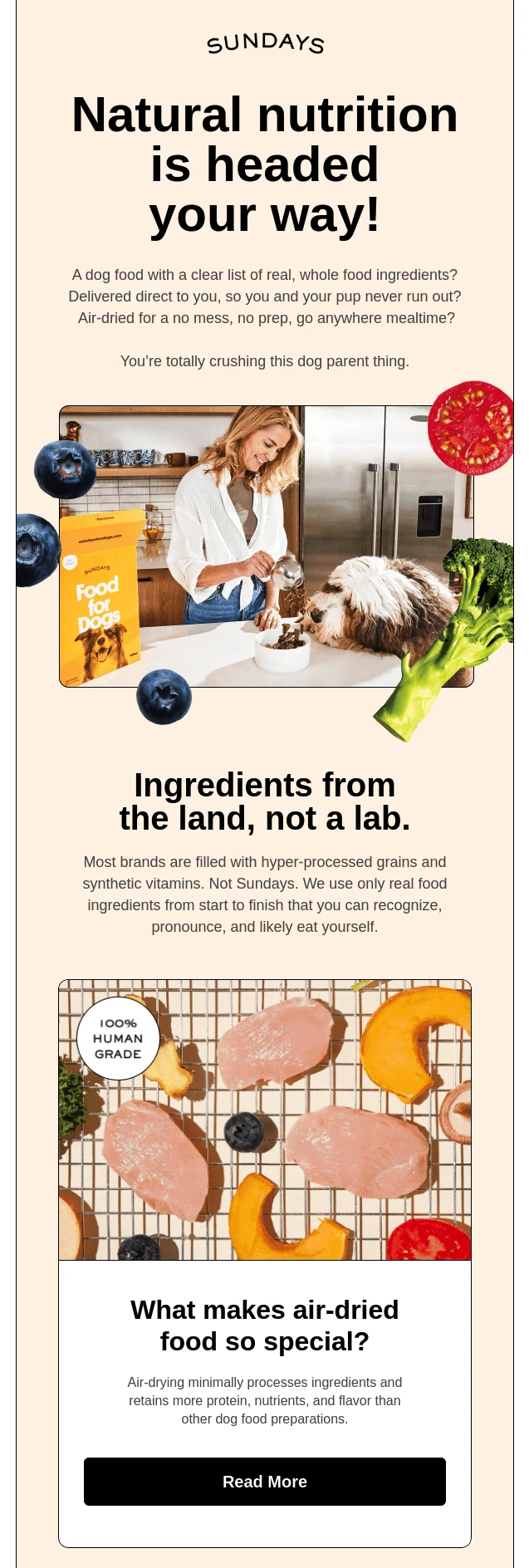
Ben Fridja, founder of the e-commerce store Fridja, thinks of his welcome sequence as a way to ensure buyers “love the product, tell their friends and maybe come back and purchase something else.”
That’s why when someone buys one of the brand’s juicers or steamers, he sends valuable information that explains how to get the most from the product.
Here are the emails contained in a typical sequence:
Immediately after purchase: A video that shows what the product does
Three days later: Setup guide
A week later: Helpful content relating to the product, such as recipes people can make with the juicer
Beyond a week: Continue to receive helpful product-related content
By creating a memorable experience rather than pushing for another sale, it’s more likely that the buyer will make a referral or a repeat purchase.
3. Abandoned cart email to save lost sales
Abandoned cart emails go out when an email subscriber visits your checkout page but doesn’t hit buy, reminding them to complete the purchase. They are one of the most effective ways to drive sales as they go out to people who are already close to buying.
When creating a cart abandonment email, keep the focus on conversion by keeping it simple.
Just include:
A headline that explains what the email is for
An image of the product
The description and price
A link back to the shopping cart
You can see a good example of an abandoned cart email in the screenshot below. Away’s message includes the product details and a simple reminder asking the shopper to “Keep shopping.”
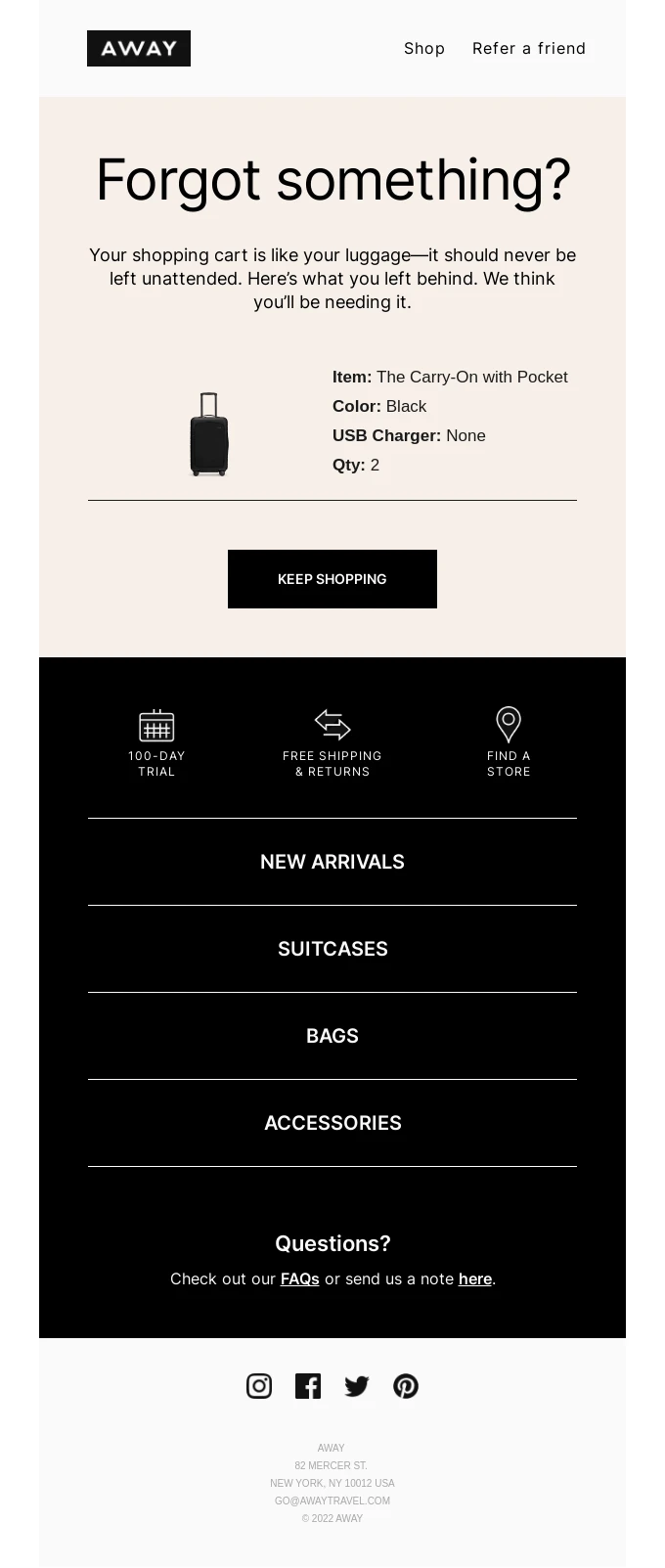
4. Interest-based recommendations to increase customer value
Interest-based recommendations are automated emails that promote products based on the customer's purchase history. You just need to use a trigger that relates to a product the customer bought.
Here are 2 ways this could work:
A sports store could use the “purchases from a specific category” trigger to promote golf equipment to people who have already bought a golf-related item.
A coffee store could use the “purchases a specific product” trigger to cross-sell its best-selling blends to people who recently bought a coffee machine.
Timing is an important factor to get right when recommending products. Leave some time between the customer buying the product and recommending new ones to give them a chance to enjoy their initial purchase.
Coursera sends this recommendation email months after the initial subscription purchase, giving the recipient plenty of time to complete the course they signed up for.
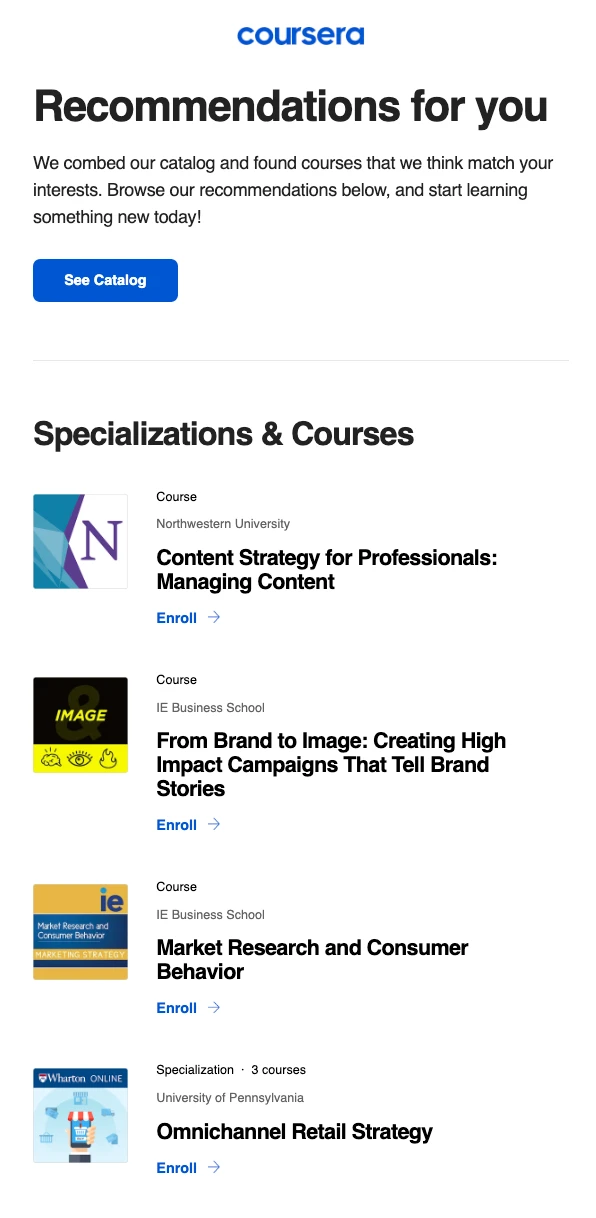
You don’t need to create entirely separate emails to recommend products. Another option is to add product blocks to your other emails. You can then use dynamic content settings to show different products to each group of customers.
5. Behavior-based recommendations to generate sales
Purchases aren’t the only trigger you can use to recommend a product. Another option is to use email link clicks to identify what customers are interested in and then send product recommendations on this topic.
MailerLite customer Notionway has a welcome email marketing automation that sends emails on topics related to the products he sells. When someone clicks on a relevant link, he uses this as a sign that the customer is interested in the product and sends further information about it.
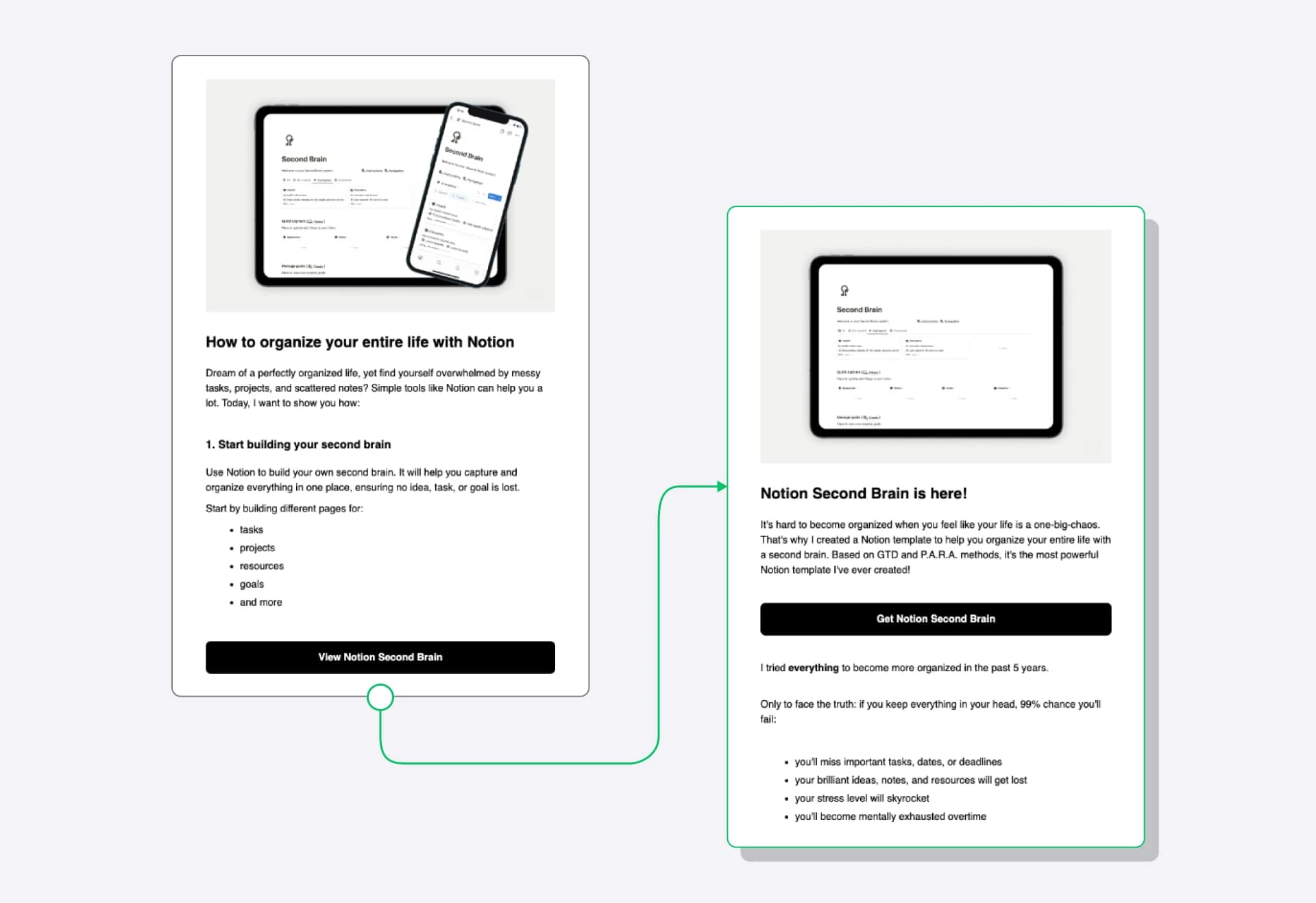
This works because, as Notionway's founder explains, “It means that people who are curious receive more emails about the products they are interested in.”
Another way to recommend relevant products is to use surveys or quizzes to discover interests and then send relevant content based on their answers. For example, a cosmetics brand could ask customers about their skincare needs and then send relevant products based on answers.
Use the “When a subscriber clicks a link” trigger to set off the workflow when a subscriber clicks a predefined link.
You can then reuse the same link in all your automations and campaigns so subscribers trigger the automation wherever they click on it. This saves time as it means you don’t have to create a separate automation for each email.
You can also choose to either let a subscriber trigger an automation a single time or let them trigger it whenever they click on the link.
6. Review request emails to increase visibility on other platforms
Email automations aren’t just for generating sales. One of the most useful workflows for e-commerce stores is sending review request emails. These emails ask people who have recently bought a product from you to leave a review on your chosen platform.
Keep them focused on the task by highlighting the recently purchased items and including a link to the platform where the customer can leave a review, just like Sports Direct does in the email below.
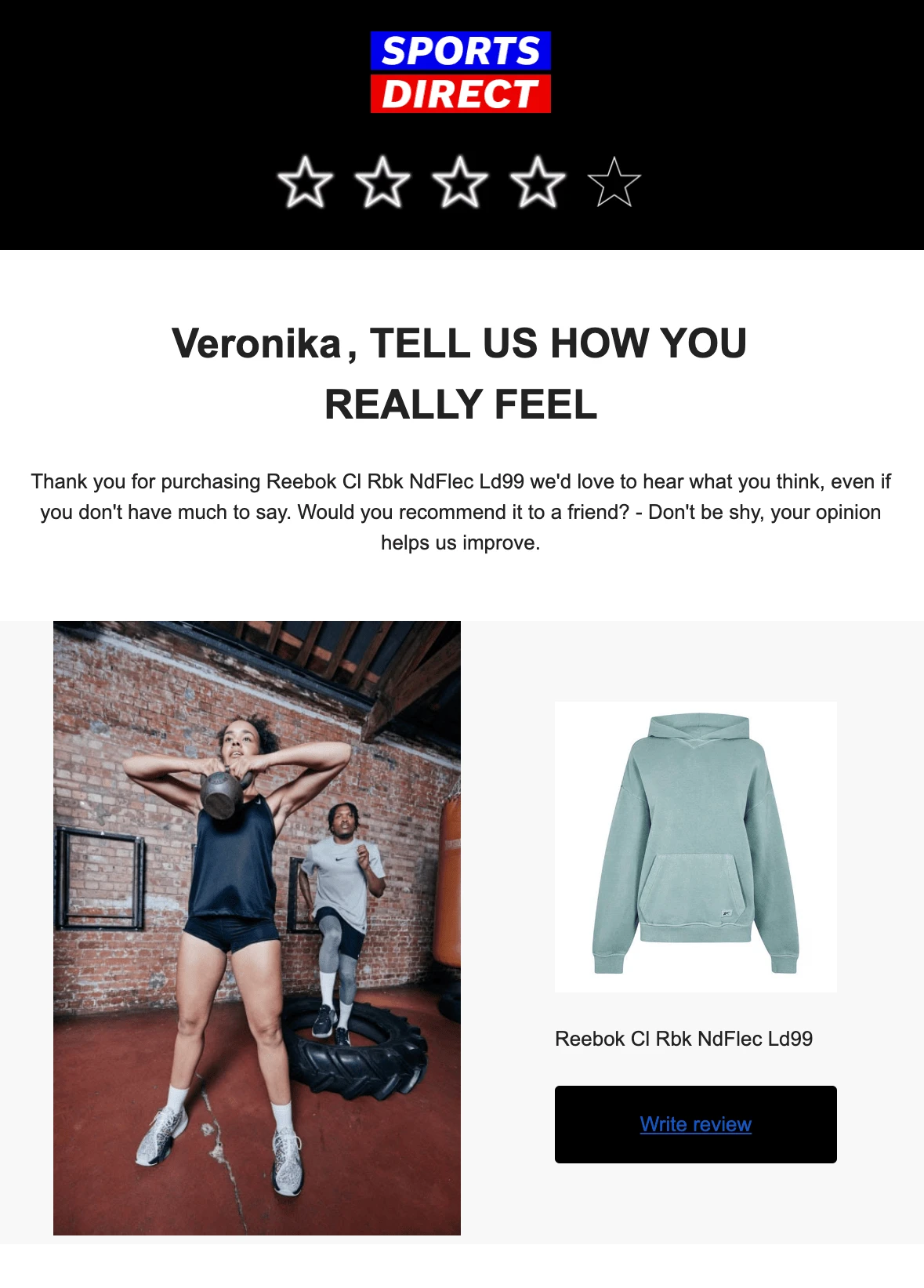
You can set one of these up using any of the MailerLite post-purchase triggers. Just be sure to leave enough time between the purchase and the review request so the customer has time to try out the product.
Guarantee positive reviews by sending an NPS survey email asking customers if they were happy with the purchase.
You can then send an automated review request email to anyone who says that they were. You can also send a follow-up email to subscribers who don’t open the initial email to increase the chances of getting a response.
7. Birthday emails to delight loyal customers
Date-based emails go out on the anniversary of a date. A common kind of date-based automation is a birthday message. Use these email marketing campaigns to send your subscribers a happy birthday message and a discount to encourage them to buy.
Adidas’s birthday email example keeps things simple by wishing the recipient a happy birthday and then providing them with a generous 20% discount that lasts until a week after the recipient’s birthday.
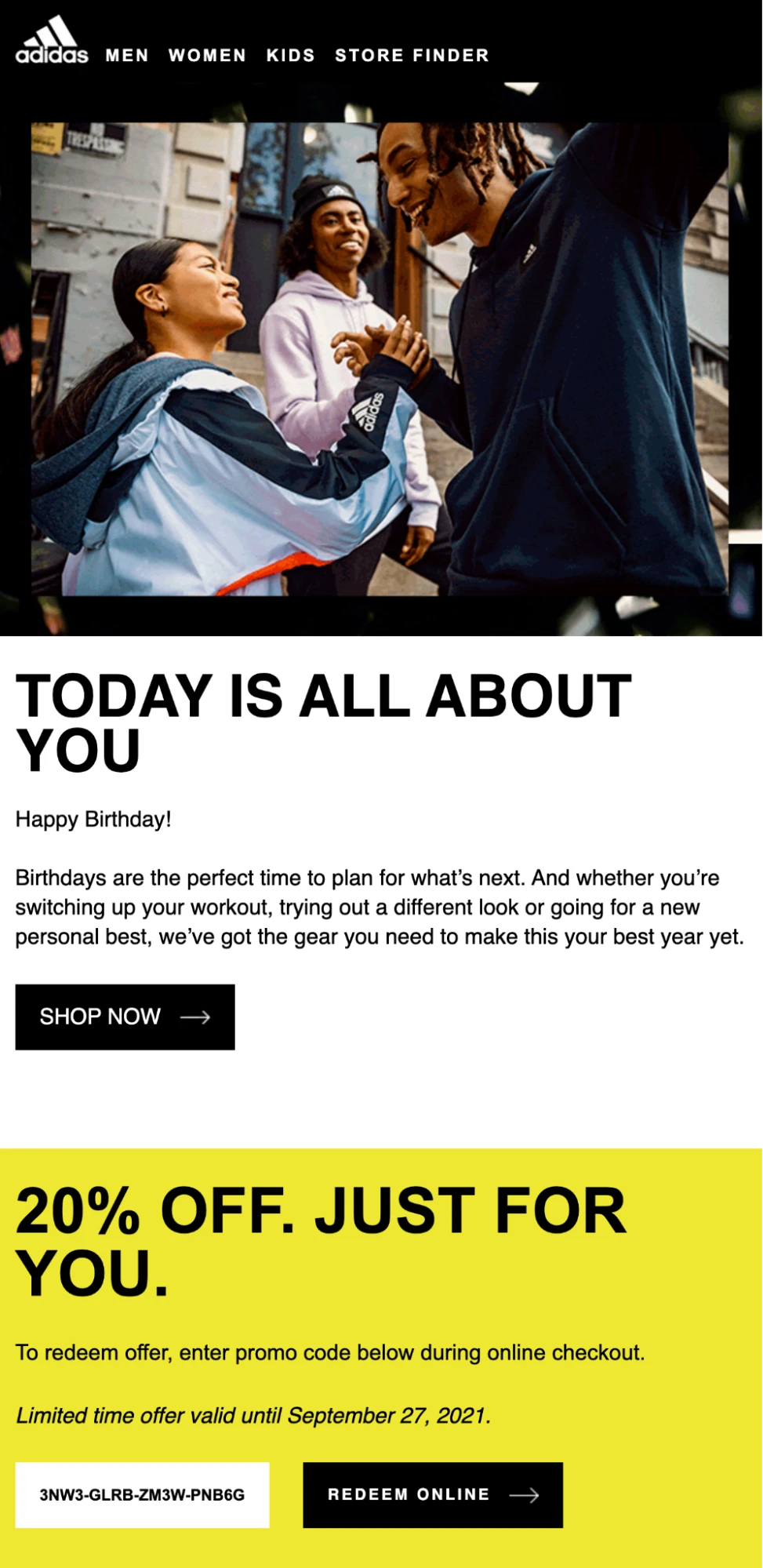
You need to know the recipient’s birthday before you can send a congratulatory message. Get this information by either adding a birthday field to your email signup form or by sending a survey email asking people to input their birthday to receive discounts on the big day.
8. Re-engagement campaigns to boost retention and value
Re-engagement emails are those you send to people who haven’t been interacting with your emails. These are typically people who bought from your store and then lost interest in your brand.
An effective re-engagement email catches the recipient’s attention by including content that stands out. Common ways to do this include offering discounts or using their name in the subject line.
Online card seller MoonPig takes the former strategy in its re-engagement campaign. The email has the subject line “15% off, because we miss you,” and the content includes a mention of its new cards and a coupon code.
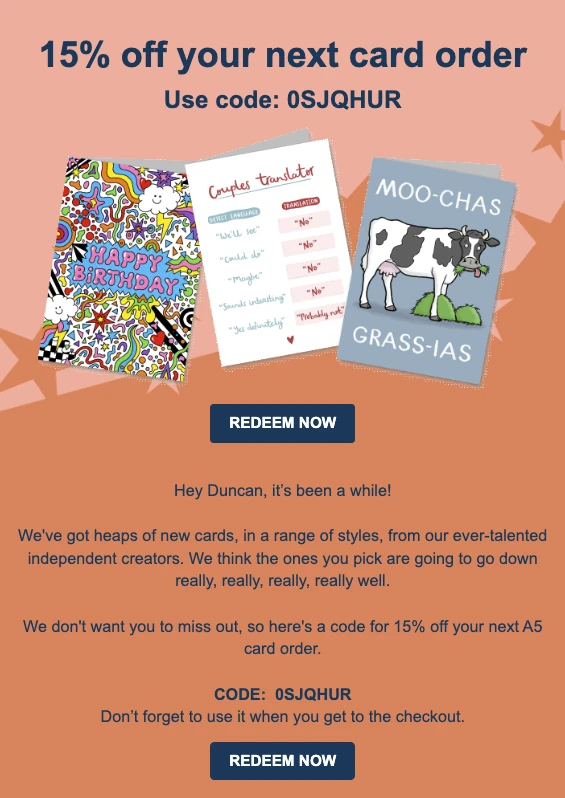
Don’t be put off if your re-engagement emails have lower-than-average open and click rates. This is almost guaranteed as you are messaging a group of people who are currently disengaged with your brand.
But if you can reconnect with even a small fraction of these people, you’ll significantly boost customer retention and value.
You can also automatically unsubscribe people who don’t interact with the re-engagement campaign, which ensures that your list doesn’t become overwhelmed with subscribers who never interact with your content. This is an effective way to boost your overall email deliverability, ensuring your messages land in your subscribers’ inboxes.
Get the most from your e-commerce email automation
Here are 4 more best practices to ensure you get the most out of your automations.
Create a reusable email template
One of the most time-consuming parts of setting up automations is designing the emails you’ll use. Save time by creating a reusable email template and then customizing it for each one.
You can also get a head start by choosing one of our pre-built email templates. Choose a design that matches your brand and then customize it to your needs. See some of our favorites in the gallery below.
With MailerLite, you can also create a template for each section in your newsletter and then reuse the most relevant ones.
For example, you could design a product box and simply drag it into place each time you want to promote a product.
Discover what works with A/B testing
Use A/B testing to optimize the steps of your automations. You could test different subject lines to see which version of an email has the best open rate, or test email content and CTAs to see which version of a product box gets the most clicks.
Personalize your emails
Use customer data to send personalized emails that are more relevant to their needs. An easy way to do this is to use information you have about the customer, such as their name, to add personalized snippets to your emails. Collect this via signup forms, surveys or a subscriber preference center.
You can also use more general information such as their interests or past purchases to create emails that target their needs.
Track the results of your campaigns
Connect your e-commerce platform to MailerLite to track how each of your e-commerce automations results in orders. You can see the exact number of sales as well as metrics like the total revenue brought in by each automation.
Start with the most essential automations, then get specific
The ideas in this article cover some of the most common types of automations. But they aren’t the only kinds of emails you can automate and your store may benefit from emails not mentioned here.
For example, if you have a referral program or a customer loyalty program, you could set up an automated email inviting people to sign up soon after their first purchase. Or you could send out a survey email to gauge people’s experience of shopping at your store.
The key is to consider the interactions that will push your e-commerce business forward and then automate relevant emails.
